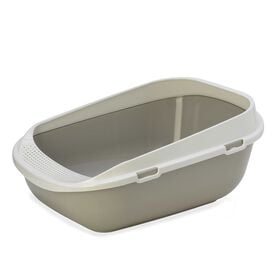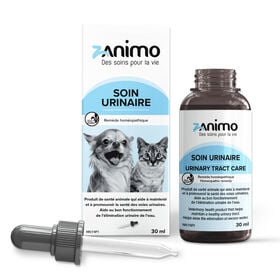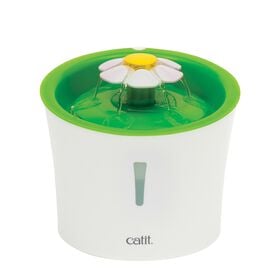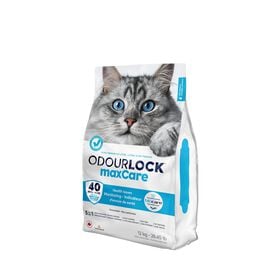If your cat spontaneously pees on your sofa or in your bed, it’s probably trying to tell you that something’s wrong. Whether it’s a simple urinary tract infection, bladder inflammation or a real urinary blockage, it’s important to contact a veterinarian immediately.
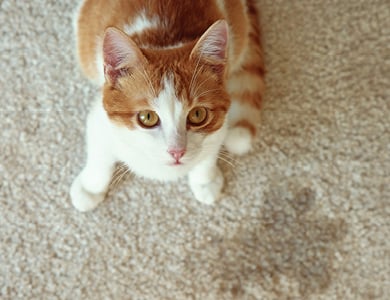
Signs of urinary problems in your cat
- Meowing when urinating.
- Blood in the urine or intense urine odour.
- Excessively licking the genital region.
- Urinating beside the litter box or in inappropriate places around the house (e.g., the sofa, bathroom, ceramic floor).
- Urinating frequently and expelling only little amounts, so that it never completely empties its bladder. “Pacing” in the litter box.
- Straining in the litterbox, but only during urination. Although you should not confuse this with constipation, you should contact your veterinarian immediately in either case.
Non-specific signs of urinary problems include abnormal behaviour: avoidance or refusal to be picked up or touched in the abdominal region, loss of appetite, sluggishness or vomiting.
If the cat is at the vomiting stage, its condition is already serious and it’s an emergency! Vomiting occurs when the cat can no longer empty its bladder. Waste normally expelled through the urine passes through the blood, intoxicating your pet and causing nausea.
If left in this state, your cat can die within 48 hours. Irreversible kidney damage, blood electrolyte disturbances and bladder rupture are among the deadly dangers associated with urinary problems. And unfortunately, they're very common in cats.
The formation of urinary crystals and stones in the bladder
A pH imbalance in the urine (too acidic or too alkaline), highly concentrated urine or elevated mineral levels (e.g., calcium, magnesium, ammonium and phosphate) can lead to the formation of crystals and stones.
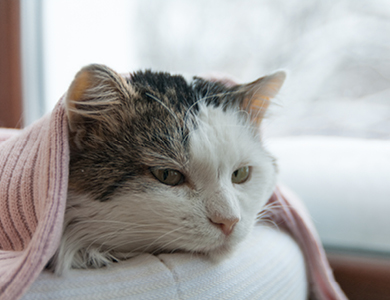
Risk factors
Several factors can increase the risk of urinary crystals:
Stress
Why? Since stress causes anxiety and changes in behaviour, kitty may be aloof, eat less, use the litterbox less often and drink less.
Excess weight
Being overweight and a lack of exercise can also lead to urinary problems.
Lack of water
If your cat doesn’t drink enough, it will urinate less, which can increase the concentration of urine, possibly causing clusters of minerals to form in the bladder.
An imbalanced diet
An inadequate diet alters urinary pH and creates sand (small crystals) in the bladder, which obstructs the urethra as it passes out of the bladder.
Your cat’s sex
Compared with females, males have a longer and narrower urethra, which increases the risk of urinary blockage.
Genetics
Some cats are predisposed and more sensitive to urinary problems.
A history of urinary problems
These cats need to be closely monitored because they are at risk of recurring problems. They should be on a veterinary-prescribed diet tailored to their needs for life.
An urinalysis, X-rays and an ultrasound can help clarify the diagnosis and facilitate appropriate treatment.
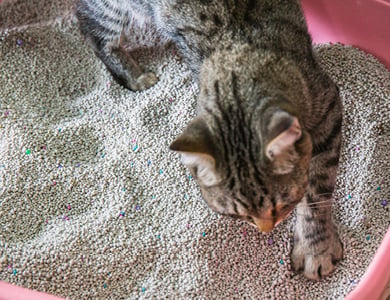
Preventing urinary problems
- Be sure to buy food that has been formulated by animal health and nutrition experts (veterinary nutritionists), so that it is balanced for your pet’s needs.
- Keep your cat at a healthy body weight by providing an appropriate amount of food and encouraging the cat to do exercise.
- Limit your cat’s stress. Like all living things, cats are sensitive to stress, and limiting stress will go a long way to preventing disease.
- Cleaning the litterbox daily will encourage your cat to use it. Cats are very clean animals and some will be unwilling to use a dirty litterbox. Choose a large litterbox without a cover. If you have a multi-pet household, have a separate litter box for each cat, plus at least one spare.
- Consider using OdourLock ultra premium maxCare litter with health indicator. This litter uses a patented technology to detect blood or glucose in urine at the earliest stage. Blood and glucose in urine are early indicators of urinary tract disease and diabetes.
- Increasing your cat’s water intake (e.g., changing water frequently, adding extra bowls or fountains) will increase the number of bladder washouts per day.
In short, remember that if you have any concerns or doubts, a quick visit to your veterinarian is always justified, especially in the case of urinary problems.



